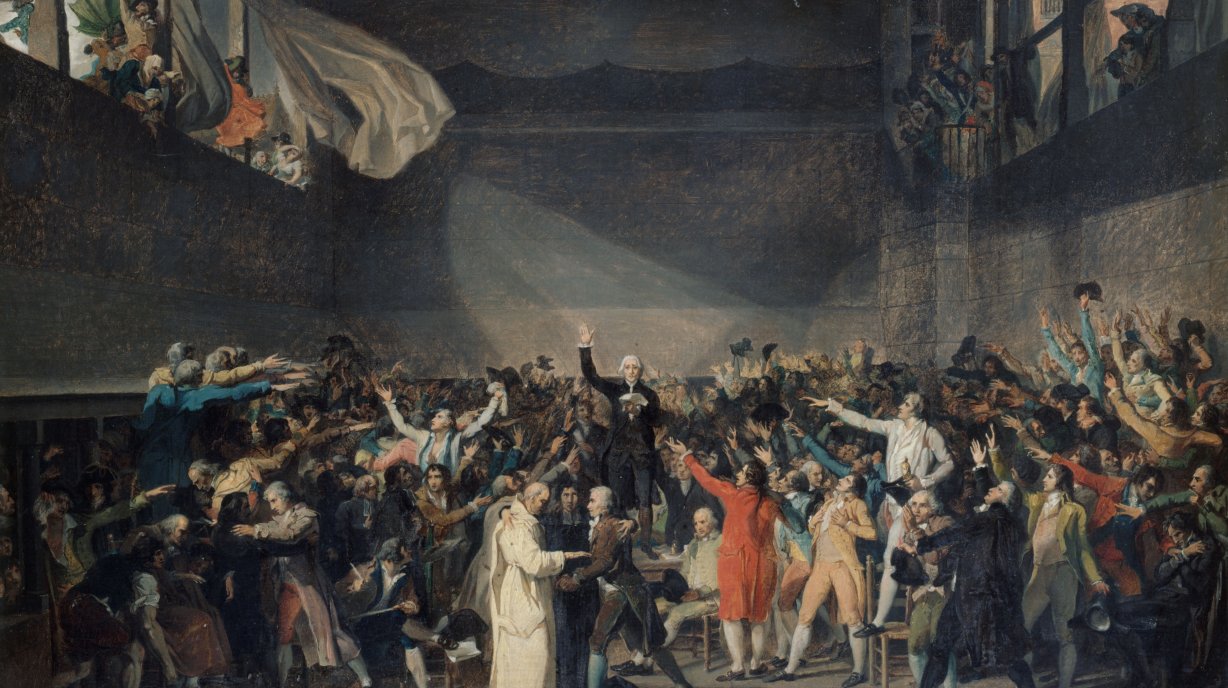
Democracy

The oath of the Jeu de Paume on June 20, 1789 © Jacques-Louis David / Musée Carnavalet
What could be more natural than reaching agreement by following the preference of the majority? Mihir Bhattacharya and Nicolas Gravel study the issue through a mathematical lens. They show that, in addition to its philosophical legitimacy, the majority is a collective preference representative of the preferences of the members of a society. Like the average, the median, or other statistical measures, the preference of the majority bears the closest resemblance to the individual preferences from which it emanates.
Deciding by majority vote, in the second round of the presidential election or to choose your next holiday destination, is a process in which we have all participated. The idea is not a recent one. Closely linked to the concept of democracy, the practice was already the subject of debate in antiquity. A certain Aristotle speaks of it as follows: "The majority (…) of whom each member is not a virtuous man may however be better than this elite [the best citizens] not individually, but collectively”.1 Following the majority could not only facilitate the making of choices, but also the taking of good decisions. Today, it is at the heart of our democratic regimes, and it is from here that their legitimacy emanates. But why is the majoritarian preference the norm, rather than any other collective preference?
Other forms of collective preference do exist. One of them is dictatorship under the leadership of a particular individual. Although this is undesirable in politics, it can be commonly seen in everyday situations (school, businesses, etc.) where one individual has authority over others. Another collective preference results from the drawing of lots. Although throwing a dart at a world map to determine your travel destination may send you twenty thousand leagues under the sea, it is by the drawing of lots that jurors of the Criminal Court in France are selected, and it was the collective preference used to designate the members of the Citizens' Climate Convention in 2019.
The French mathematician Hervé Moulin argues in favour of a collective preferences that minimises the chances that the worst will happen in a situation where there are more options to choose from than decision-makers. Unanimity may get everyone approval but is hard to achieve. Indeed, this means giving the right of veto to all individuals in a group. While this could be possible to implement in a small group, only a miracle would allow 67.8 million2 French people to find a subject on which they would all agree!
Another collective preference is that resulting from consent. One option would be considered over others, as long as there were no important or reasonable objection. This method is part of a mode of governance known as sociocracy, which also includes elections without self-proclaimed candidates.3 Tested notably by the municipal council of Auray (Morbihan), the consensus requires long debates before reaching a decision. It differs from unanimous decision-making since not all stakeholders have an unconditional veto.4
Adopting the majority choice is, therefore, a collective preference among a range of others. What explains therefore its pre-eminence?
In the early 1950s, economist Kenneth Arrow suggested an answer to this question. According to him, a "good" collective preference should respect five conditions: universality (collective preference must be defined whatever are individuals’ preferences), rationality (any two options must be compared, and the comparisons must be consistent), independence (preferences of members of the community for a third alternative must not influence the collective preference for the two alternatives under consideration), respect for unanimity (when unanimity is reached, it must be respected) and, of course, the absence of a dictator. Unfortunately, his doctoral thesis led him to conclude in 1951 in the impossibility to satisfy these five conditions. Indeed, Arrow's theorem of impossibility states that any universal, rational collective preference that satisfies independence and respects unanimity is a dictatorship. This result, extremely pessimistic about the possibilities of defining the general interest as a synthesis of individual interests, was qualified a year later by another Kenneth.5

©Esther Loubradou / Aix-Marseille School of Economics
In 1952, Kenneth O. May indeed demonstrated, in the case where society is made up of an odd number of individuals, that majority is the only collective preference option which satisfies the following conditions: anonymity (the characteristics of the members of society other than their individual preferences must not influence the collective preference); neutrality (the characteristics of the options other than those which determine the preferences of the individuals for them must not influence the collective preference); monotony (a modification of an individual preference in favour of one option cannot reduce the ranking of this option in the collective preference) and the fixed aspect of the collective preference (the two options must always be collectively comparable).6 This result, although limited to the choice between two options, is good news for the majority. It argues that the majority is, in a sense, the best way to turn individual preference into collective preference. In keeping with this tradition, economists Mihir Bhattacharya and Nicolas Gravel provide a somewhat different justification for the pre-eminence of majority.
When studying data, which are often collections of numbers, it is common to attempt a representation of those data by a single number. Thus, in the case of school exams in France, the question of the class average is paramount. Pupils’ and parents’ interest in the average – which in the end may differ significantly from the individual grade the student obtains – can be explained by the fact that the class average is "representative" of the level of the class. There is a mathematical way to express this representativeness: the average (for the class) is, among all the possible grades, the one which minimises the sum of the squares of the differences between itself and the individual grades obtained in this class. From this point of view, the average grade of the class is therefore "close" to the grades of the students in the class. Of course, averages are used in many other contexts: we speak of average height, average weight, or average salary.
The median is sometimes preferred over the average. Economists thus consider it more representative to speak of the median wage – which divides the population of employees into two equal parts, one half being under of the median, the other over – rather than the average wage. The median wage is also a wage that is "close" to those wages being considered, in the sense that the sum of the differences is minimised between the median wage and those wages (which is not the square of the differences, but their absolute values).
Mihir Bhattacharya and Nicolas Gravel consider whether, therefore, the majority could make it possible to represent preferences mathematically, like average or median relates to school grades, physical measurements, or salaries. Answering this question requires a notion of proximity - distance – between preferences rather than between numbers. What is meant by the fact that two preferences can be "close", or two preferences can be "distant"? M. Bhattacharya and N. Gravel identify in their article all possible notions of such distances, which are minimized by majority preference. They identify everything which allows a majority to be representative of the preferences from which it is derived. They show that a lot of those distances are reduced by the majority rule. This is therefore a strong argument in favour of the preference of the majority. Just as the average allows us to visualise the level of the class, the majority enables us to imagine the preferences of individuals. Does this mean that the majority make good decisions?
Locke, Hobbes, Sieyès, Rousseau, and Condorcet are among the many authors who have questioned the use of the preference of the majority, and its legitimacy. The concept of the majoritarian preference has been both praised and criticised: praised for reflecting the preferences of individuals and for treating individuals equally; criticised because it does not consider the intensity of individual preferences, and it can also lead to the "tyranny of the majority" of which John Stuart Mills spoke in the nineteenth century. According to Albert Camus "Democracy is not the law of the majority, but the protection of the minority".

Tyranny of the majority ©Redpanels/Wikimedia Commons
In our democratic systems, safeguards have been put in place to protect individuals from the undue consequences of implementing the preference of the majority. One such safeguard is a chart of human rights that protect individuals from possible majority intrusion. The principle of equality constitutes both a foundation of majority (through equality of votes) and one of its limits (the equality of individuals, which should prevent a majority from depriving a minority of its rights). To give a relatively recent example, not even a majority preference in the French population could demand that the death penalty – abolished in 1981 – be re-instated to punish the perpetrators of the Bataclan attacks in 2015.7
If following the preference of the majority has its flaws, mathematics show that this is a collective preference representative of the individual preferences from which it derives, in a stronger sense than the way an average class grade represents the grades of the class's students. It is only reasonable, therefore, that the majority of us should find ourselves in favour of the majority.